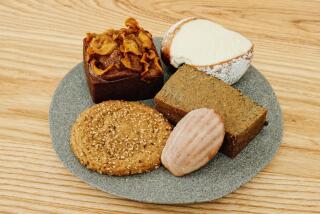Recipe Decoder
- Share via
Key to Times Style
Unless otherwise indicated, make the following assumptions in Times recipes.
Butter: unsalted (sweet).
Eggs: large.
Flour: all-purpose.
Fruit and vegetable sizes: Onions and other items are assumed to be medium.
Milk: whole.
Oil: vegetable oil (canola, peanut, safflower, etc.).
Sugar: granulated.
Glossary
Cellophane noodles: Translucent noodles made from mung bean flour. Available at Asian markets.
Dried red dates (daichu): Korean “dates” are the barely sweet Asian fruit otherwise known as the jujube; they are considered to have medicinal powers. Available at Korean markets.
Kimchi: Pickled cabbage or other vegetables fermented with garlic, anchovy sauce and ground red pepper. Available at Korean markets.
Mung beans: A small, quick-cooking legume best known in this country as the source of Chinese restaurant bean sprouts. In Korean cooking, it’s used in soup or as in a sweet filling for rice cakes. Unpeeled mung beans are green, and hulled ones are yellow. Available at health food stores and Asian markets.
Potsticker wrappers: Pasta circles made from wheat or glutinous rice flour. Wonton wrappers may be used, but your dumplings will be triangular instead of crescent-shaped.
Rice Cakes (ttok): Steamed cakes made of rice flour. They come in many shapes and varieties, filled or plain, sometimes sweetened. Available at Korean markets and Korean bakeries.
Rice flour: Ground rice used for making rice cakes or thickening dishes such as bindaetuck. Available at Asian markets.
Rice Wine: An alcoholic drink made from rice.
Sikae: Sweet rice drink. Available at Korean bakeries.
Silgochu: A shredded dried red chile that looks like long threads of saffron. It’s used to garnish and to flavor meat, fish and vegetable dishes. Available at Korean markets.


